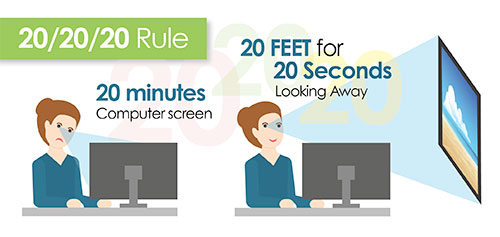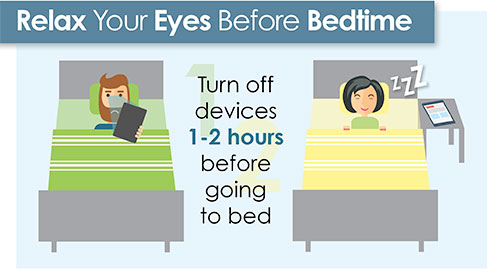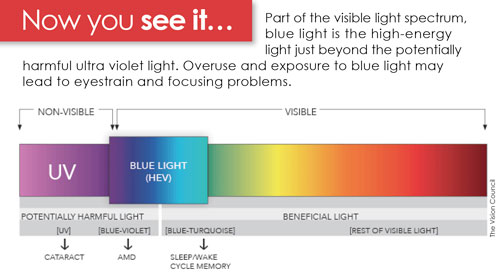Nearly 90 percent of adults use digital devices for two or more hours per day, according to The Vision Council’s 2016 Digital Eye Strain Report, exposing consumers to blue light that some suggest is dangerous.
Adam Gordon, O.D., clinical associate professor at the University of Alabama at Birmingham School of Optometry, believes overuse and exposure to blue light may lead to eyestrain and focusing problems, but does not appear to cause long-term harm, eye disease or damage to the retina.
“Lens manufacturers have jumped on the band wagon of harmful blue light and are creating products that they claim will protect your eyes from macular degeneration or other eye diseases,” Gordon said. “Blue light more often causes eye discomfort and annoyance than physical harm. It is important to understand what blue light is, where the accusations of hazard and threat of blue light come from, and how it truly affects your vision.”
What is blue light?
Part of the visible light spectrum, blue light is the high-energy light just beyond the potentially harmful ultraviolet light.
Blue light is normally transmitted through the eye to the retina, because it is visible light that our eyes are designed to receive. Light is visible to the eye and triggers the visual process that leads to vision and sight.
A large body of experimental and clinical evidence over 20-30 years shows that UV light can be harmful to the eye and contribute to diseases such as cataracts, pterygia or growths on the front of the eye, and perhaps macular degeneration. Most eyeglass and sunglass lenses and many contact lenses have been developed to block out UV light.
Compact fluorescent light bulbs, high-intensity headlights and other LED lighting do emit higher blue light energy than more traditional incandescent light bulbs, causing excess exposure to blue light than we received before. Digital devices such as TV screens, computer monitors, cellphones and tablets also emit significant levels of blue light. The higher levels of blue light place more strain on the eye’s focusing system than do printed materials. 
Is blue light harmful to the eyes?
Digital eyestrain refers to blurred vision and other symptoms such as burning, stinging or tearing of the eyes associated with prolonged use of digital devices. Digital eyestrain leads to dry eyes and puts strain on the muscles that help the eye focus. When staring at a digital device, the eye does not blink as frequently, and this causes faster disruption and evaporation of the tear film that protects the ocular surface. When the surface of the eye begins to dry, irritation is felt, such as burning and stinging.
When viewing digital devices, the eyes are looking at a pixelated image that is rapidly alternating or flickering multiple times per second. It is much harder for the visual system to maintain a sharp or consistent focus on an electronic image compared to a hard image.
There are numerous eyeglass lenses now available to selectively block out the high-energy blue light that contributes to the fatigue and strain placed on the eye’s focusing system. For people who spend significant hours on a computer or other digital device, these lenses may provide some relief and comfort.
To further maintain comfortable vision while using digital devices, it is important to use the 20/20/20 rule. For every 20 minutes of digital device use, look away for 20 seconds focusing on something 20 feet away. Using artificial tear or lubricant drops may also relieve some symptoms of dryness.
There is some early laboratory research using animal models that suggests excessive blue light exposure can damage some sensitive cell layers of the retina. There is no clinical evidence at the present time that links blue light exposure from digital devices to any pathology or disease of the eye.
“Some advertisements from lens manufacturers are misleading consumers to believe that blue light from digital devices will cause serious harm to their eyes,” Gordon said. “Products created to block out blue light minimize eyestrain when using computers and digital devices, but have not been tested or shown to prevent any type of eye disease.”
Macular degeneration and other eye diseases in relation to blue light is the great unknown. The main risk factors for these eye diseases are age, genetic factors, UV light, smoking and poor nutrition more than digital device use.
Benefits of blue light
One of the physiological benefits of visual light, specifically blue light, is the relationship with our internal circadian clock. As part of the sleep/wake cycle, blue light triggers the suppression of melatonin in the brain, keeping us awake. This tells us when we are tired or should be awake.
“We are not designed to be using our phones and tablets 6 inches from our faces, particularly when we are lying in bed with the TV on,” Gordon said. “This is suppressing the melatonin, making it more difficult for a good night’s rest and REM sleep.”
Turn off your devices one to two hours before going to bed to trigger the release of melatonin, giving it a chance to increase just before dozing off into deep sleep.